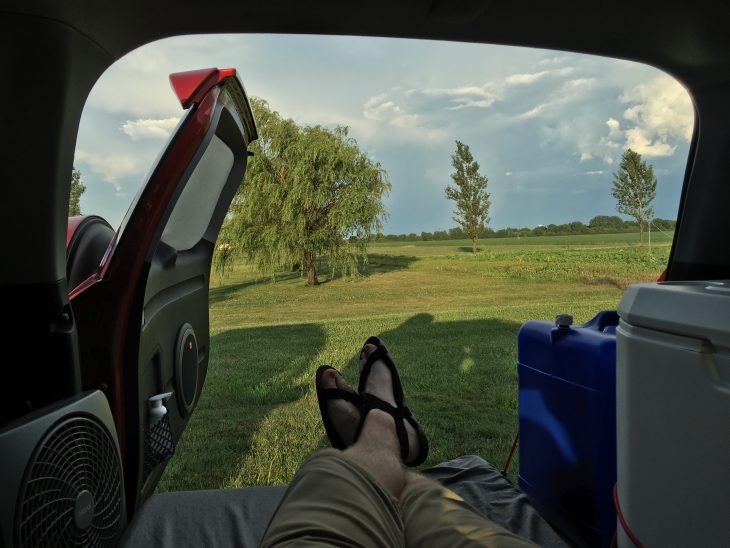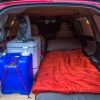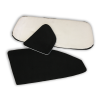While planning my summer trip, which I would embark on in my RAV4 camper conversion, I came to terms with the fact I would have to sleep in some of the country’s hottest places. Most of us who go out on extended road trips do so in the summer months for various reasons, and therefore: how to stay cool when sleeping in a car becomes a very important thing to think about. In this article I’ll share some of the techniques and systems I built before leaving to prepare for places still in the 90’s with the sun down.
With just a few strategically placed fans, enough open windows, knowledge on how to cool your own body naturally, and picking proper bedding materials, sleeping in extremely hot and humid places becomes bearable, if not sometimes enjoyable.
Passive vs. Active
Before I start telling you which fans I bought or how to cool your body naturally, let’s get into a little theory which will help explain concepts presented in this article.
And you can trust me on this topic because: I’m a rocket scientist, and I know thermodynamics! Well, actually I’m an aeronautical engineer, meaning atmospheric vehicle designer. “Airplane designer” doesn’t have the same oomph as “rocket scientist” and the two degree paths take the same thermodynamics classes, so give me a break…
There are two fundamental ways we can cool the interior of a car camper: passively and actively. Passive meaning that the air is not cooled directly, and active meaning that air is actively cooled. An example of these could be: a car’s air conditioner unit actively cools the air, and a fan or open window passively allows heat to escape. The fan only moves the air around, but does not add or subtract heat energy. An AC unit pulls heat and humidity from the air and expels that heat outside of the cooled space.

Active systems can obtain nearly any desired temperature, but consume lots of power doing so. While passive systems can usually only equalize the temperatures between two spaces through a boundary. Most of the topics I’ll cover in this article will be passive cooling systems. I’ll talk about one active cooling solution at the end of this article, and why you might not want to use it.
Practicality
Why should you care? Regardless of outside air temperature, cooling is important for car campers because the human body is a heater. If you keep all the windows closed, the car’s interior can easily reach tens of degrees over the ambient temperature. Personally, I don’t like the sound of the 90° forecast turning into 110° in my car, so what can we do about this?
Well, the first option would be to use the car to actively cool the interior space. But, running your car’s AC and engine all night is… completely impractical. My car burns about a quarter tank every two hours on idle with the AC on. That means in only eight hours I would have an empty tank, and a $50 per night gas bill (using average gas prices). Running your car’s AC or a portable unit is also only possible with a battery the size of every available free space in your car.
Even full sized class A RV’s don’t use battery power to run their AC units, they use generators. Running a generator outside your car in a Walmart parking lot doesn’t lend itself to the word “stealthy.” If your car can do better than mine and you have the money to spend, then go for it! But be aware of the potential security risks of a running car and that some states have made it illegal to sleep in running vehicles.
Now let’s go back to those passive solutions. If we can’t bolt on an AC unit to the car then, as I said above, the best we can do is equalize the interior and exterior temperatures. By cracking windows and using fans to push hot air out of the car this is actually very achievable, but kind of discouraging…
Air Circulation
When I found out the best cooling I could do would be to match the car’s interior to the exterior air temperature, I became discouraged to visit states with high night time temps. Lucky though, there is something else that we can do to lower the perceived temperature without active cooling. Because the body radiates heat, a thin layer of air around the body is always warmer than the surroundings. Even in extreme cold, exposed bare skin can keep significantly warmer than the air if… there is no wind.
Wind chills are what make cold exposure dangerous, because the wind strips this warm air layer away from the skin and exposes the body to full cold. This “feels like” temperature, as it’s often called, is important to look at in winter forecasts, and is extremely useful to us trying to stay cool when sleeping in a car. If we can strip the warm air away from the skin intentionally, then our bodies will perceive the air as about 20° colder than what it really is.
A fan can easily do this. Creating artificial wind not only helps to circulate air and prevent heat pockets from stagnating, but it also lowers our perception of how hot it really is. On really hot nights I direct the fan’s airflow straight onto me. Using this technique while also having a system to expel hot air from the car is what has allowed me to sleep well during extremely hot nights. Now let me show you how I do it.
Vent Fans
Hot air rises. I think everyone knows that. However, when I remind myself of this simple fact, so much makes sense. When designing a car camper for stealthy summer trips, taking a look into the car with this knowledge can reveal a lot. Where’s the highest point in the ceiling? What features of the car can trap heat from escaping? Is cracking open some windows enough?
Your car could be like mine, where the tops of the window frames are several inches lower than the ceiling. This raised ceiling acts like a bowl for hot air and if not dealt with the hot air will displace the cold causing unnecessary heating throughout the night (this is a good thing in the winter, more on that in a future post!).
If I could, I would cut a huge square hole in the top of my car and install a Fan-tastic Fan, which are the extractor fans seen in RVs and van conversions. But as it is, I don’t want to permanently alter my car. There were two options that I saw to get rid of this hot air: use the sunroof or pull the hot air down and out of the windows.
My 2009 Toyota RAV4 has a sunroof. It can either be opened all the way, or while it’s close the back edge can crack open about three quarters of an inch. Unfortunately, this opening is way too small to let the hot air naturally escape. I wanted to use this feature to get rid of hot air stuck inside, since the sunroof opening was very discreet. I could build a ducted fan to push air from inside the car, out that small slot in the sunroof. Similarly, this could also be put into the side windows if your car doesn’t have a sunroof.

By pushing out hot air from the car these vent fans also pull fresh air through the other open windows, which then sinks and fills the sleeping area. In theory, this kind of fan is probably the most important tool when trying to stay cool when sleeping in a car.
My 3D Printed Vent Fans
I wanted my vent fans to be compact, able to be run off of a USB battery pack, nearly silent, and still be powerful enough to flush out the hot air quickly. I found this set of fans designed to be used to cool a gaming cabinet: Amazon Link. The fans are run off of USB power and had a very low amperage draw of about 1 amp hour. This amp draw meant with my 20,000 mah or 20 amp hour battery pack (Amazon Link) I could run the fans for about 20 hours, plenty for overnight use.
With parts in-hand, I designed shrouds to fit each fan to my car’s sunroof opening:


The design was done in a program called OnShape. It’s a web based, free to use CAD program and it’s also very easy to use. They don’t pay me anything, but I like the software so much I try to promote them a s much as possible, so here’s a link: Onshape.com
Anyway, I had to design the ducts to be printed in halves since they were too big to fit on my 3D printer. Also, they were calculated to use more than 40% of a 1kg roll of plastic, so I decided to print each half in a different color so I could save some of each color for later.

Each half took 7 hours to print, so that’s about 28 hours to print the set (not including setup and filament changing).

Once a print was done, I removed it from the bed and broke out the support material. This was added so the inside walls would be defined and not all droopy from the printing process.

Each half was then screwed onto the fans, which is the main way the two sides were held together. I added some very sticky masking tape to the seam preventing misalignment and air leakage. Then I removed the fans and spray painted the shrouds to match.

Adding the fans back on, you can see that I left the tape on there to help hold the assembly together.

Cleaning up the wires a little with zip ties:

And here’s the finished product! The fans nest together really well, and the cord works great to tie them together. In this view you can also see the extended flange on the top of each shroud. This flange hooks onto the edge of the sunroof frame holding the fans in place (in theory…).


Finally, here’s what the vent fans look like when placed in the sunroof opening, as seen from my DIY RAV4 Conversion Youtube Video.

Some Future Vent Fan Improvements
While these vent fans did work great, I have had some issues with them too. Three main problems were revealed to me shortly after I started sleeping in my car: the material choice was poor, I needed a better way to lock them into the sunroof opening, and the fans were too big.
I used PLA plastic to print the vent fan shrouds. This is a really nice plastic to print, partially due to its low melting temperature. This also meant that it had a low structural temperature limit. English? The plastic tended to melt from the heat of a car sitting in sunlight. Several times, a found the shrouds all misshapen and had to reform them into a usable shape. One time it was so bad I had to borrow a hair dryer to get them to even fit back into the sunroof opening.
This constant reshaping also contributed to the vent fans falling down from their perch regulartly. A few times one even hit me in the face! That flange that rested against the sunroof window frame was not large enough to ensure the security of the fans. Later in the trip I discovered that I could slowly lower the sunroof and pinch the fans in place. I’d like to avoid this behavior though because I don’t want to but any stress on the window or motors.
Finally, while designing these I realized the fans were too big, but continued anyway. When designing a duct like this, you want to keep the input and output areas the same to ensure good airflow. The largest I could make the sunroof side of the duct would be 27″ by 0.75″, that’s 20.25 square inches. Dividing that area in half is 10.125 square inches, and the diameter of a circle with that same area is 3.6″. The fans I chose have a diameter of 4.7″. This means I could have used smaller fans to get the same airflow with less power and sound. I realized this after feeling a lot of back pressure escape around the fan blades while the vent operated. The fans were forcing in 70% more air then the ducts could actually pass through. This is a bit nit picky, but something I will probably update in the future.
I’m currently working on a version of these vent fans that can be built by hand with readily available materials. I’ll release plans and instruction to this website once I’m done, so be sure to check back here or join my mailing list to receive updates.
Interior Fans
When searching for a fan to accompany me inside my car camper, I had a few requirements in mind. The fan needed to be quiet, so I could sleep easily. It also needed to be powerful, to get air moving fast. Through my experiences at several summer camps, I also knew I wanted a fan that was rechargeable opposed to lugging along boxes of D cell batteries
Luckily, I was able to find a fan that met all those criteria: the O2COOL 10 inch Smart Power Fan (Amazon Link). It has an internal 5 hour duration rechargeable battery and can be loaded with a handful of D cells for a total of 56 hours of runtime off the alkalines. It comes with a 12V car adaptor for charging. The fan is very powerful and quiet enough that I never had a problem while sleeping with it.
5 hours doesn’t sound great for the rechargeable, but the smart power feature automatically switches between the batteries when one becomes low. The fan will always use the rechargeable battery first and then switch to the D cells. Similarly, if the fan is plugged into the DC power supply then it’ll use that to run the fan and recharge the batteries at the same time.
I was able to charge the fan everyday which meant I only used 3 hours of the alkalines per night instead of 8 hours. Also, the 5 hour rating is for the high setting, when I ran the fan on low, the rechargeable lasted about 8 hours. This feature allowed me to fill the fan with a set of D cells that lasted months, I carried along a second set and never touched them on my travels.
I do have a few gripes with this fan that I think are important to share. The indicator lights are brighter than the sun! So, I simply put a layer of gaffers tape over them all and that fixed that.
My other gripe: the fan can sometimes drain its rechargeable battery without being on. There is a four position mode switch on the side, from bottom up it reads: OFF, SLOW, STOP (which is the position used to charge the batteries without the fan running), and FAST. If the switch is on OFF while the adaptor is plugged in then it won’t charge. And if you accidentally leave the fan in STOP, the USB port on the side used for charging external devices will drain the rechargeable battery. I’ve forgotten about it several times and found the rechargeable battery never charged, or it drained after I left it in STOP for too long. Now that I know these things though, I am more careful and they rarely happens.
If you don’t want to mess with the rechargeability, O2COOL also makes roughly the same 10 inch fan that is just battery powered which is also a great option (Amazon Link).
Bedding
One aspect of staying cool while sleeping in a car that I totally overlooked was how I set up my bed. Personally I don’t like sleeping with just a sheet on me, I’d rather just not have anything, so I only brought a blanket. But, the much more important consideration I overlooked was the fabric choice I went with for my bedding. I used a set of cotton jersey sheets and pillowcases, terrible terrible idea.
Jersey fabric is a knit fabric used for T-Shirts. The fabric is very soft, comfortable, and warm! The texture of your bedding plays a big role on how hot you will be in it. Soft fabrics like knits, microfibers, fleece are all great insulators, which is exactly what we don’t want. Try finding some 500 to 600 thread count or higher sheets that you like. These will be smoother, less grabby, and feel colder than the previously mentioned insulators.
I don’t have any product suggestion to show you since it’s all personal preference. But, I would recommend finding a set of Twin sheets you like and using safety pins to fix it to your cot size mattress (Amazon Link) instead of trying to find a cot sized set, which are hard to find and more expensive.
Personal Preparations
As I mentioned above, there are several simple things that can be done prior to crawling into bed to help keep the human body cool while sleeping in a car. The first of these concerns dinner. Eating a small dinner or skipping the meal entirely will decrease your bodies ability to warm itself. The digestive system is a very powerful heater and needs to be considered on those especially hot nights.

If you can’t bare not eating, try to consume cold, light foods and do so several hours before bed. For example, salads, sandwiches, celery or carrots (The image above is a kale and turnip salad with avocado vinaigrette dressing I made while WWOOFing with Tir-na-nOg farms in Maine.). Snacks and sustenance like these will prevent the furnace of the body from firing up and keep you cool through the night.
Another preparation that saved me several times while sleeping in my car was: taking a shower before bed. I would keep a gym membership while traveling through populous areas and their showers there were always a welcome sight. I’ll talk in depth on how to find showers while on the road in a future post.
 Getting clean right before bed makings your bedding feel all the more comfortable and inviting. The leftover moisture on skin and hair will also evaporate slowly which will create additional cooling. And when you wake up, you’re ready for the next day!
Getting clean right before bed makings your bedding feel all the more comfortable and inviting. The leftover moisture on skin and hair will also evaporate slowly which will create additional cooling. And when you wake up, you’re ready for the next day!
Finally, I would usually keep some chilled water in my cooler which I could dump into my HydroFlask (Amazon Link) to keep the water cold through the night. Taking sips of this while starting to fall asleep does a lot to cool off the body. Of course drinking too much causes other problems that have to be dealt with later on in the night, but a few sips go a long way.
With all these preparations, I never sweated on even the hottest nights. Especially with taking a shower right before bed, I would only feel a sensation of warmth similar to being under a blanket, but it wasn’t enough to make me sweat. This feeling of warmth was actually very enjoyable and I came to appreciate sleeping on those especially hot nights. I find these intentionalities highly overlooked and invaluable to know.
Evaporative Coolers
Now we finally get to the only active cooling option of this post. You’ve probably heard of evaporative coolers, also known as a “swamp cooler”. They cool the air by pulling it through a moist sponge material that adds water to the air. The act of evaporating water from the evaporation pad, cooles the air at various rates. A swamp cooler can knock down the air temperature by up to 20 degrees at optimal conditions, and the same unit can humidify and heat the air in most other conditions, let me explain.
Evaporative coolers only work really well if the air doesn’t already contain water. If it’s really dry, adding a bit of humidity to the air will pleasantly cool there air while also taking off that edge of dryness. Conversely, swamp coolers can’t add more water to air that’s fully saturated already. Running an evaporative cooler when the ambient humidity is close to 100% (as it routinely gets to at night on the east coast) will only feel like a fan since no water can be evaporated from the evaporation pad.
So if you’re planning a trip to a destination with a hot and dry climate then you should definitely get an evaporative cooler! Well, not so fast. There’s one other caveat to this active system. These units don’t act like air conditioners. If operated in a closed space, the ambient humidity will just keep increasing. Water vapor is a great insulator and will immediately start heating the space, while the swamp cooler is no longer able to produce cold air, and the interior walls are getting soaked with condensation. To avoid this scenario, lots of airflow in and out of the space is required to keep the air’s humidity down, so the evaporative cooler can stay effective.
I have not added a swamp cooler to my setup yet, maybe I will if I take some trips to the desert… But, if you think having an evaporative cooler is still useful to you, here’s the best portable unit I’ve seen so far: Amazon Link.
Summary
I hope that I’ve shown in this article that it’s possible to get through the really hot nights of a summer road trip with a handful of preparations. By opening your windows as much as you can, using some kind of vent fan, having a good interior fan, preparing your body by showering, eating light, and drinking cold water, even the hottest most humid nights can still be bearable. Alternatively, you could follow the advice from my How to Sleep Comfortably in A Car Article, where I suggest planning trips to climates you’d like to be in. Even so, at least you are now prepared for the worst!
One last piece of advice: There will be nights that are just too hot to get a full nights sleep from. No matter how well you prepare, you will probably miss some sleep. For this reason, I kept a hammock in my car at all times. The thin breathable nylon allows full air circulation above and below the body. Setting this up below a shady tree in the middle of the day, I’ve taken some much needed naps outside my solar powered oven of a car. I highly recommend these to people thinking of living out of a car because a hammock can give you a larger sense of living space. Anyway, here the setup I use: ENO Double Nest (Amazon Link) and ENO Atlas Chroma Hammock Straps (Amazon Link) (Pst.. they have more colors than just red, so you can get one to match your car too!)
 How do you keep cool when sleeping in your car? Did I miss something? Comment below, I look forward to hearing your thoughts!
How do you keep cool when sleeping in your car? Did I miss something? Comment below, I look forward to hearing your thoughts!






[…] To learn more about staying cool check out this dedicated article: How to Stay Cool When Sleeping in a Car […]
I would really like to see an update post on the improvements you’re making to the 3D printed vent fans. I’ve been trying to figure out something similar for my 2010 Rav4. Would you be willing to share the STL files you created?
Love this idea and so far to me best yet. Have you given the though to selling these. I am interested, need one.
Hi!
I have a ’16 RAV4 and am considering doing my retirement travel alternating between car-sleeping two nights in a row, Airbnb for one night, and two more CC nights.
I haven’t the skill to design and execute a 3D design like you have done but want to try the Fantastic Fan-through-the-sunroof idea.
I’m thinking about cutting a thin piece of plywood that fits perfectly into the opening. Screw and glue it onto another thin piece a few inches wider, so that the previous piece is like a ‘cleat’ that holds the bigger piece in place. Surround the cleat with some type of waterproof weather stripping. Cut out a 14″×14″ hole for the fan and glue a rubber floor mat (that’s tapered around the edges) to it. Use a razor to cut rubber out of the hole, mount the Fantastic Fan, and use sealant to cover screw holes and seam.
Wire it to a battery pack and voila: redneck ventilation!
(Please shoot some holes in this idea before I waste money, lol!)
Thanks!
Hi, Thanks for your video and blog! I have a RAV4 hybrid with a sunroof. I am concerned about moisture buildup. I came o learn about your exhaust fans. I’m wondering if a 02cool fan suspended by a cargo net would keep the moisture down. Did you ever figure out another exhaust fan idea?
Hi Lucas
Hope your well?
I have a question about sleeping space. At 5′ 8″ in height do you think there’s enough room for me to sleep on a platform without moving the passenger seat forward?
Ta
Les
would love to hear ideas on sleeping in cold weather
You inspire me! I change My car scion XB with your advise! I will go to a trip and try my setup! It’s most like yours!
Tank you for the inspiration!
Helene W
I’d would love to show you! How can i do that?
Hey this is a very cool fan concept I’d like to try it out myself!
Did you ever design an updated shroud? Could you share your new/old CAD files?
Have you thought abuse using those big cooling mats they sell at kmart for dogs? I think they are like a gel mat, they would pull heat out of your skin for sure!
Lucas, would you be able to share the digital files for the 3d printed fans?
Everything I’ve found online seems to really suck, and not in a good way.
Cheers
Quick question not completely related to sleeping, but I have a similar car with the same type of trunk hatch. When I leave my hatch open, my car battery dies. All of the lights on running boards and ceiling are off. If there something else I need to do?